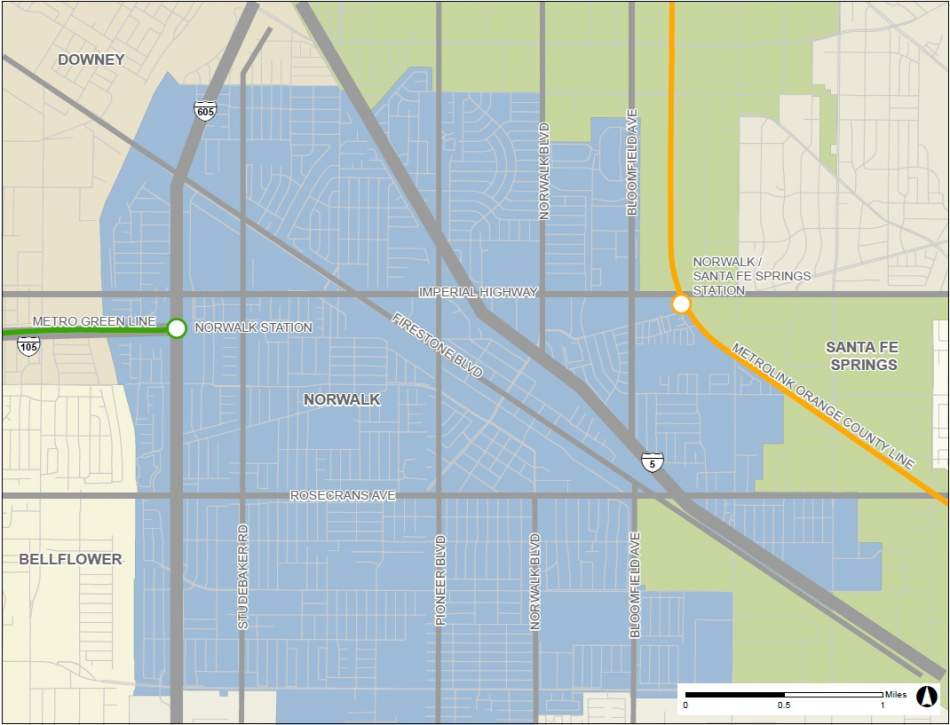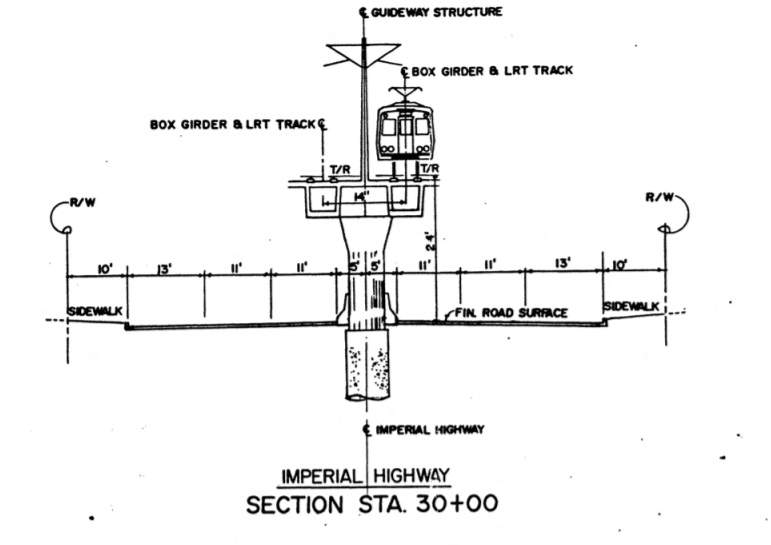The Southern California Association of Governments kicked off a yearlong feasibility study for a Metro rail extension this week with an open house for Norwalk residents.
The proposed extension would take the Metro Green Line to a new eastern terminus adjacent to the Metrolink Station in Norwalk, bridging a 2.8-mile gap that has long been a target of transportation planners. SCAG is working in conjunction with Metro and OCTA, as well as the cities of Norwalk and Santa Fe Springs to determine specifics, including potential routes, station locations, and land use surrounding the corridor.
The study will also identify possible funding shortfalls for the project, which is one of the last Measure M transit corridors to receive funding under the 50-year expenditure plan. The Green Line Norwalk extension is due to receive $200 million in unadjusted dollars beginning in fiscal year 2046.
Despite a delivery date more than three decades in the future, the study will begin as part of Metro CEO Phil Washington’s ambitious proposal to bring some of the agency’s transit projects to “shovel ready” status. Metro intends to complete technical studies and environmental documents for nearly 20 projects, so that they quickly begin construction in the event that outside funding should become available.
At the open house, residents and other community stakeholders were invited to view maps of the study area and give their opinion on the project. Residents were asked about their relation to the existing Norwalk transit facilities, and how they felt Metro could better serve the city.
Commenters mentioned feeling that the Metro Green Line and the Metrolink Orange Line stops did not serve local citizens, and that they were instead being used as a shortcut for regional travel. Post-it notes on the display boards bemoaned a lack of parking spaces available at both locations, with many spots reserved in advance by regular patrons.
Staff at the event noted that the agencies involved were interested in hearing whether residents felt that there was a need for an intermediary stop to better serve the community, and pressed attendees to voice their opinion on land use that they would like to see surrounding potential stations. The request was met generally with skepticism by residents of a city that has endured nearly five years of construction on the 5 Freeway.
In general, those in attendance from Norwalk, a suburban middle-class town to the southeast of Los Angeles, were not so much hostile to the thought of a rail line traversing their city as they were perplexed by how they could make it benefit them. Commenters said they did not personally know people that used public transportation, or if they did, that those trips were adequately covered by Norwalk Transit, a municipal bus service.
One woman noted that Norwalk Town Center would be an appropriate destination for a rail station, a suggestion which was met with general approval, only to then add that she thought it was too far south of the planned termini to be of much use.
A man suggested that Metro patrons would use Norwalk as a regional cut-through but that few if any of them would spend money within the city, regardless of where an extra stop might be placed. The crowd of citizens wondered then whether or not it was even worth putting in an extra stop to service Norwalk, or if passing transit riders should just be taken from one end of town to the next as quickly as possible to get them on their way.
SCAG will be seeking to provide some answers to all of these questions during a planning process that is expected to conclude by March of 2018. In July of this year, a second round of community meetings is planned to discuss the preliminary land use recommendations and alternatives developed by the study.
A gap closure project between the Green Line and Norwalk’s commuter rail station was also studied in the early 1990s, before being indefinitely shelved in the wake of financial difficulties and a federal consent decree. Planners identified the gap as an impediment to better service for inbound commuters from Orange County headed toward aerospace industry jobs in El Segundo and LAX passengers even before the Green Line and the OC Metrolink line formally entered service. That project reached the Final EIR stage, maintaining an alternative that followed Imperial Highway in either a fully-elevated or fully-underground alignment.
While the basic study area remains the same, some aspects of the study have changed since 1993. SCAG hopes to bring Norwalk residents into the process by considering placing a stop somewhere along the nearly 3-mile route, where previously the emphasis had been on maintaining an average speed of 40 mph between the Green Line and Metrolink. In view of that, the LACTC only used fully grade-separated alternatives in their study.
The current study will also evaluate the potential for at-grade rail to be used for all or part of the project. Perhaps the two most significant aspects for the project’s potential to improve regional travel are two rail infrastructure projects that are occurring beyond the scope of SCAG’s current work. The LAX people mover is scheduled to connect the Green Line to LAX in the early 2020s, while later in the decade, Norwalk may also have a station on the state’s first high speed rail line.
Scott Frazier is a graduate student at Cal State University Los Angeles in Public Administration. Follow him on Twitter @safrazie.








